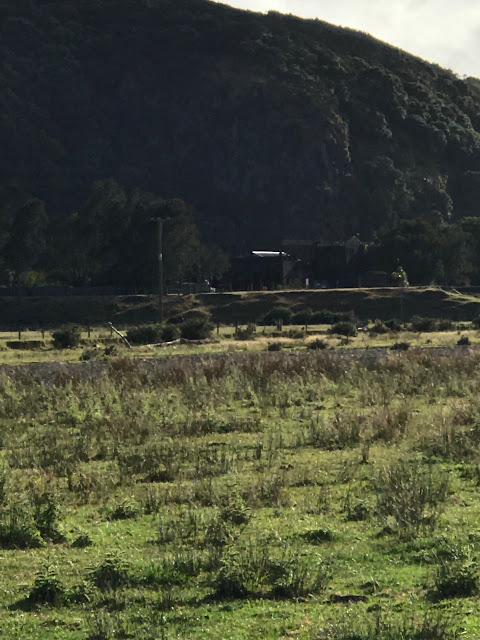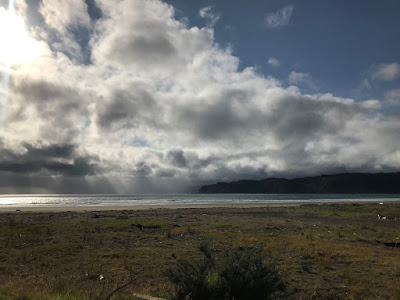In my earlier post on Dylan Horrocks graphic novel Hicksville (1998), I mentioned that this page of his comic reenacts a classic scene from John O'Shea's 1964 film Runaway.
The scene with the car in O'Shea's film is (you'll no doubt recall) set up north, on the Hokianga harbour, whereas Horrocks' imaginary "Hicksville" is located in Hicks Bay, near the tip of East Cape.
More than fifty years on, East Cape really is one of the last parts of New Zealand where you can recover that sense of emptiness and distance which were once an essential part of the local experience. As the poster says: 'Set in the New Zealand you know' - or, rather, that you once knew.
So, on our latest drive back home from Wellington, we decided to go the long way round. Headed for Hicksville? You betcha!
•
How do you get there?
Well, obviously the first thing to is to check it out on the map. I knew that the road would be pretty rough from Gisborne, but I have to say that I hadn't remembered that the route from Napier to Gisborne was so long and demanding. East Cape, with its wide open spaces and gentle curves, was quite a rest-cure by comparison!
Tolaga Bay was the scene of a particularly traumatic childhood holiday for Bronwyn, so we were duty-bound to stop and take a look at the place. It gives you some sense of the territory, I think - a few sandy footprints, a driftwood-strewn beach, a half-empty campground ...
•
Where should you stay?
There's really only one answer. If Hicks Bay is your destination, then the Hicks Bay Motel Lodge is the obvious place to hang your hat.
Situated on the hill above the township, there's certainly no shortage of magnificent views. The buildings themselves seem to date from another era. They've been modernised a bit inside, but from the outside they look like nothing so much as the Christian Youth Camps we used to get sent to periodically when my parents wanted a bit of peace and quiet.
There's even a restaurant - with a bar and off-licence attached. There's not a lot of choice, really, but we did enjoy our meal there, nestled romantically in the far corner of the dining room.
•
Why Hicks Bay?
I've already mentioned the Dylan Horrocks connection: Hicks Bay is the approximate setting for his imaginary hamlet of Hicksville, "a quiet seaside town where the beach is sunny, the tea is hot, the locals are friendly, and everyone loves comics", as the blurb to the slightly expanded 2010 version has it:
Every detail of this town is etched in the memory of his fans: The Rarebit Fiend tearooms; Mrs. Hicks' Hicksville Book Shop and Lending Library; Kupe's lighthouse, home of the secret comics library ...
And, for a moment at least, one can almost persuade oneself that it's really (almost) all there:
Rarebit Fiend, anyone?
There is, of course, a lot more to the place than that. Thirty years before Hicksville, New Zealand novelist David Ballantyne wrote a dark, strange, moody thriller, set in the imaginary beach settlement of "Calliope Bay," which just happens to bear an uncanny resemblance to Hicks Bay.
There was an old man who lived on the edge of the world, and he had a horse called Sydney Bridge Upside Down. He was a scar-faced old man and his horse was a slow-moving bag of bones, and I start with this man and his horse because they were there for all the terrible happenings up the coast that summer, always somewhere around.How's that for an arresting opening? It's almost as if he'd set out to beat the celebrated first sentence of The Scarecrow, published just five years before:
- David Ballantyne. Sydney Bridge Upside Down. 1968 (Auckland: Longman Paul, 1981): 5.
The same week our fowls were stolen, Daphne Moran had her throat cut.If you're curious to know more, there's an excellent discussion of Ballantyne's novel and its background on pp. 162-67 of Bryan Reid's After the Fireworks: A Life of David Ballantyne (Auckland: Auckland University Press, 2004).
- Ronald Hugh Morrieson. The Scarecrow. 1963 (Auckland: Penguin, 1981): 1.
Nor do the literary antecedents end there. Four decades later, Steve Braunias decided to play the place a visit, and this is how he begins his account:
There was an old man who lived at the edge of the world. 'When I look back on my life,' Lance Roberts said, 'I've done a lot of killing.
I met him at his monstrous house. Someone had once written that they heard screams and bleats there on still nights. Outside, the long horizontal line of the blue Pacific looked sharp as a knife. The blade flashed in the bright sun. It cut the sky in half.
- Steve Braunias. 'Hicks Bay: A History of Meat.' In Civilisation: Twenty Places on the Edge of the World. 2012 (Wellington: Awa Press, 2013): 1.
Here's Lance Roberts' "monstrous house", the old Hicks Bay freezing works, seen from the road, half-hidden by trees - then closer up:
And here's "the long horizontal line of the blue Pacific":
•
Hicks Bay or Hicksville?
Just a few atmosphere shots to remind us what it's like if we ever feel tempted to go back there.
Though, to be honest, I'd really have preferred to have stayed a bit longer. It sure is peaceful there. Edgy, yes - Braunias is right about that, but there's no point in pretending that we were even able to start on the long task of unravelling its mana and mystique.
I don't know if this trip means that I'll be able to appreciate Hicksville - or, for that matter, Sydney Bridge Upside Down - any better from now on, but there's no denying that Hicks Bay certainly is unique.
And those of you who've never explored the East Cape of New Zealand are definitely missing something: a tiny window on what the country used to be, how it felt to drive around it in my father's station waggon some fifty years ago.
•

















































